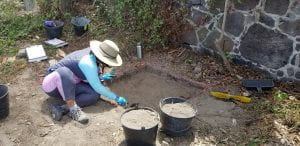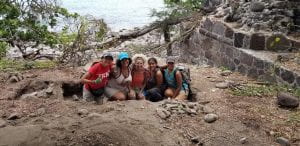By: Gabriela Y Ruiz-Vélez
I bet you’re probably wondering who am I, well I’m no less than Gabriela Y. Ruiz Vélez. I was born on the tiny Caribbean island of Puerto Rico and I’m currently an incoming third year student majoring in Archaeology at the University of Puerto Rico. You’re all probably wondering how this girl from the Caribbean got such opportunity for this amazing program. Well, I first found out about the internship provided by the Research Experience for Undergraduates (REU) through Facebook, thanks to the Anthropology association of my college. This program got my interest mainly because it provided minorities a bigger chance and opportunity to apply and it made me a little more confident. Even though I had all the requirements, I still hesitated applying, for various reasons like finding out about it a bit too late and most importantly because I was afraid that they will not choose me because I’m still young, lack experience and I was barely finishing my second year. Nevertheless, I stripped away my fears, decided to apply and to my surprise I got selected! Therefore, this blog post will be about my experience in the island of St. Eustatius, starting from the work in the field to all the beautiful people that live on St. Eustatius.
We were on St.  Eustatius from June 11 to July 2 of 2018 and there are no words to describe the ways that the REU has helped me in my training for my education. It was fascinating applying everything I learned from my theories classes to the field experience. Before starting to dig, the program mentors trained us in the proper way to dig on a unit, since it’s very important not to damage the possible artifacts we may find. In total we dug around 11 units, I got the opportunity to dig mostly with my coworkers Gelenia and Kaylee. After collecting buckets of dirt, we screened it on a sifting screen and bagged it afterwards. We worked from Mondays to Saturdays, the latter being focused on lab work. The lab work was done on St. Eustatius Center for Archaeological Research (SECAR) from 2:00 through 4:00 pm on Mondays to Friday and from 9:00 am to 12:00 pm on Saturdays. The lab was mainly focused on cleaning the artifacts with delicacy to not damage them. Everything we did in the field was written in a field notebook provided by the program. I’m sure you’re all wondering what we did when we were not working. Not much really, during our free time we would just tour around the island, feeling welcomed by the locals who are until now the most nicest people I have ever met.
Eustatius from June 11 to July 2 of 2018 and there are no words to describe the ways that the REU has helped me in my training for my education. It was fascinating applying everything I learned from my theories classes to the field experience. Before starting to dig, the program mentors trained us in the proper way to dig on a unit, since it’s very important not to damage the possible artifacts we may find. In total we dug around 11 units, I got the opportunity to dig mostly with my coworkers Gelenia and Kaylee. After collecting buckets of dirt, we screened it on a sifting screen and bagged it afterwards. We worked from Mondays to Saturdays, the latter being focused on lab work. The lab work was done on St. Eustatius Center for Archaeological Research (SECAR) from 2:00 through 4:00 pm on Mondays to Friday and from 9:00 am to 12:00 pm on Saturdays. The lab was mainly focused on cleaning the artifacts with delicacy to not damage them. Everything we did in the field was written in a field notebook provided by the program. I’m sure you’re all wondering what we did when we were not working. Not much really, during our free time we would just tour around the island, feeling welcomed by the locals who are until now the most nicest people I have ever met.
During my work time in St. Eustatius I learned numerous things. One of the things that I learned was the important role that the enslaved people played in St. Eustatius. Similarly, thanks to the tour guide and the visit to the visit to the St. Eustatius Museum I learned some history of the island. This includes the “First Salute” between St. Eustatius and the United States, its importance as a port, and how it is home to various nationalities today. I also learned how to properly clean the artifacts and how to bag them by lot, units and level. During this time in St. Eustatius, we started planning our research projects. I’m working with our graduate assistant, Taylor Bowden, and we are analyzing the Afro-Caribbean ware from Fort Amsterdam and Battery Rotterdam. We will identify the different types found at both sites and compare them. For last and not least important, we will be determining the influence globalization had over the communities living at both sites.
Escrito por: Gabriela Y Ruiz-Vélez
Apuesto que te preguntas quién soy yo; pues nada más y nada menos que Gabriela Y. Ruiz Vélez. Nací en una diminuta isla del Caribe llamada Puerto Rico y voy a cursar mi tercer año de Arqueología en la Universidad de Puerto Rico, Recinto de Rio Piedras. Usted probablemente se estará preguntando cómo esta chica caribeña obtuvo esta oportunidad en este grandioso programa. Bueno, primero encontré información acerca de este internado provisto por el Programa de Experiencia de Investigación para Subgraduados (en inglés REU) a través de la página de Facebook de la Asociación de Antropología de mi universidad. Este programa llamó mi atención principalmente porque motivaba a las minorías a participar y eso me dio mas confianza para llenar la aplicación. A pesar que poseía todos los requisitos para ser aceptada todavía dudaba en solicitar por varias razones; entre ellas que estaba un poco tarde para llenar la solicitud, porque era muy joven, carecía de experiencia en el campo de arqueología y apenas estaba terminando mi segundo año de universidad. Sin embargo, me despoje de mis temores y decidí solicitar y para mi sorpresa fui seleccionada. Es por eso que este “blog” va a ser dedicado a mi experiencia en la isla de San Eustaquio comenzando con el trabajo de campo hasta llegar a mis vivencias con los habitantes de esta hermosa isla.
Estuvimos en la isla de San Eustaq uio desde el 11 de junio al 3 de julio de 2018. No existen palabras para describir las formas en que el REU me ayudó a adquirir experiencia en mi campo de estudios. Fue fascinante aplicar los conocimientos adquiridos en las clases teóricas al trabajo de campo. Antes de comenzar a excavar, el programa de mentores nos entrenó en la forma correcta de remover tierra de una unidad, ya que es bien importante no dañar los posibles artefactos que podamos encontrar. En total excavamos cerca de 11 unidades y tuve la oportunidad de hacerlo junto a mis compañeras Gelenia y Kaylee. Después de recolectar cubos de tierra, la misma tenía que ser cernida con un cernidor, para luego empacar los artefactos encontrados.
uio desde el 11 de junio al 3 de julio de 2018. No existen palabras para describir las formas en que el REU me ayudó a adquirir experiencia en mi campo de estudios. Fue fascinante aplicar los conocimientos adquiridos en las clases teóricas al trabajo de campo. Antes de comenzar a excavar, el programa de mentores nos entrenó en la forma correcta de remover tierra de una unidad, ya que es bien importante no dañar los posibles artefactos que podamos encontrar. En total excavamos cerca de 11 unidades y tuve la oportunidad de hacerlo junto a mis compañeras Gelenia y Kaylee. Después de recolectar cubos de tierra, la misma tenía que ser cernida con un cernidor, para luego empacar los artefactos encontrados.
Trabajamos de lunes a sábados enfocándonos en las tardes en trabajo de laboratorio. El trabajo de laboratorio fue realizado en el Centro de Investigación Arqueológico de San Eustaquio (en inglés SECAR) desde las 2:00 pm hasta las 4:00 pm de lunes a viernes y los sábados de 9:00 am a 12 pm. Este se enfocaba principalmente en limpiar delicadamente, y sin dañar, los artefactos encontrados. Todo lo que hicimos en el campo era documentado en una libreta provista por el programa. Estoy segura que se preguntarán qué hacíamos cuando no estábamos trabajando en la investigación. Pues realmente no había mucho que hacer; durante nuestro tiempo libre paseábamos por la isla y nos sentíamos bienvenidos por sus habitantes quienes, hasta ahora, han sido las personas más amables que haya conocido.
Durante mi trabajo en San Eustaquio aprendí muchas cosas. Una de ellas es el papel tan importante que jugaron las personas afro descendientes esclavizadas en la isla. Igualmente, gracias a nuestra guía turística y a la visita que hicimos al museo de San Eustaquio pude aprender parte de la historia de San Eustaquio. Esto incluye el “Primer saludo” entre San Eustaquio y los Estados Unidos de América, su importancia como puerto y cómo es el hogar hoy día de varias nacionalidades. También aprendí cómo limpiar apropiadamente y empacar de manera correcta los artefactos encontrados por lote, unidad y nivel. Durante este tiempo en la isla comenzamos a planificar nuestro proyecto de investigación. Estaré trabajando con la asistente graduada Taylor Bowden, en el cual estaremos analizando los fragmentos de la cerámica afrocaribeña encontradas en Fort Amsterdam y Battery Rotterdam. Vamos a identificar los diferentes tipos de fragmentos encontrados en ambos sitios y compararlos. Por último, y no menos importante, vamos a determinar la influencia que tiene la globalización sobre las comunidades que vivieron en ambos lugares.